Intended definition : Used to describe those who cross the Sonoran desert or those who carry a cross.
Ongoing project_ 60 images_ Inkjet Prints, Canson Infinity on dibond framed or blue back, variable format.
California & Arizona, US, 2017-now.
Since January 23, 2017, when he took office, Donald Trump has reinforced a massive border security system, implemented in 2012 with a budget of $475 million, by the Obama administration. This border protection system, intended to arrest illegal immigrants, is called into question by citizen associations and activists who unite against the controls of immigration agents operated at a distance from the border, in what is known as the Constitution Free Zone. This 100-mile-wide strip that follows the contours of the country “diffuses” border status to exempt itself from the application of the Fourth Amendment. Arizona may seem like a very unexpected place for a movement to fight against policies linked to immigration, whereas it is this state which implemented the very controversial law SB 1070 which gives Arizona’s police the right to verify the identity of any person suspected of having entered the territory illegally. Simultaneously, local humanitarian associations are organizing. Humane Borders, maps the bodies found in the desert and installed their offices of prevention and information on the Mexican side. In the area, there is a daily routine and habit of aid brought often for years. Each weekend, Border Angels and Humane Borders gather those who wish to drop water jugs in remote areas of the desert. The tanks installed in the past are now monitored by border patrol and avoided by those who cross illegally. Since the end of 2018, the government has prosecuted volunteers of the association No More Deaths for their assistance to illegal immigration. At the start of 2019, the charges against them were dropped. A few miles north of the border, the Constitution Free Zone is a series of desolate landscapes. In this control zone, which should only be marked by those who pass by, we are permanently prevented and stopped, it seems that we are reaching “that stagnant distance, where we have arrived and where we may be, we will never leave.”
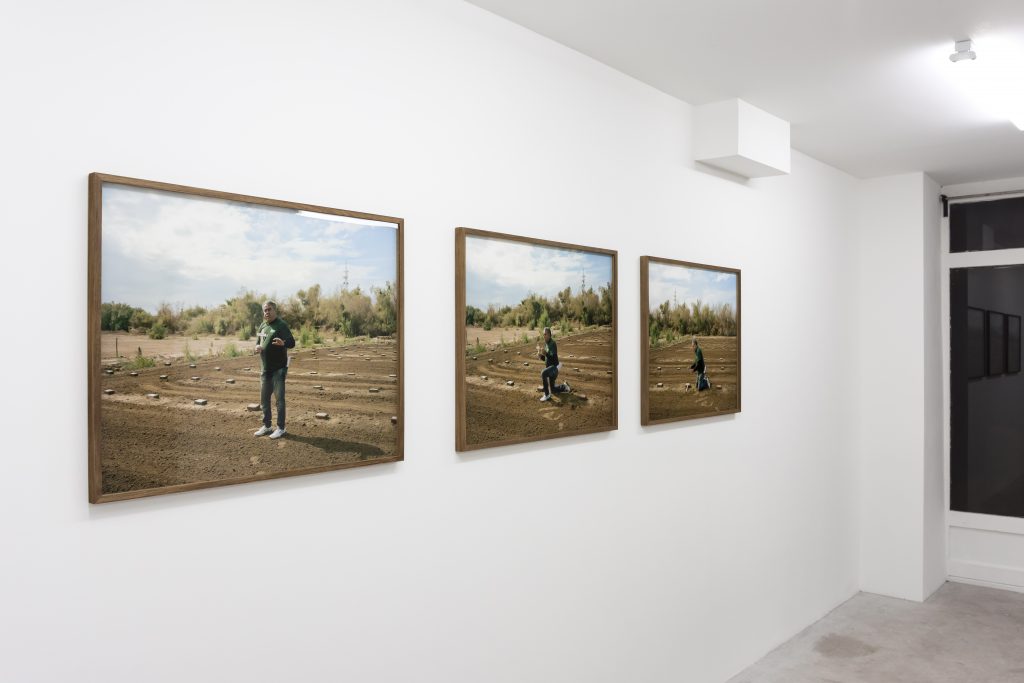
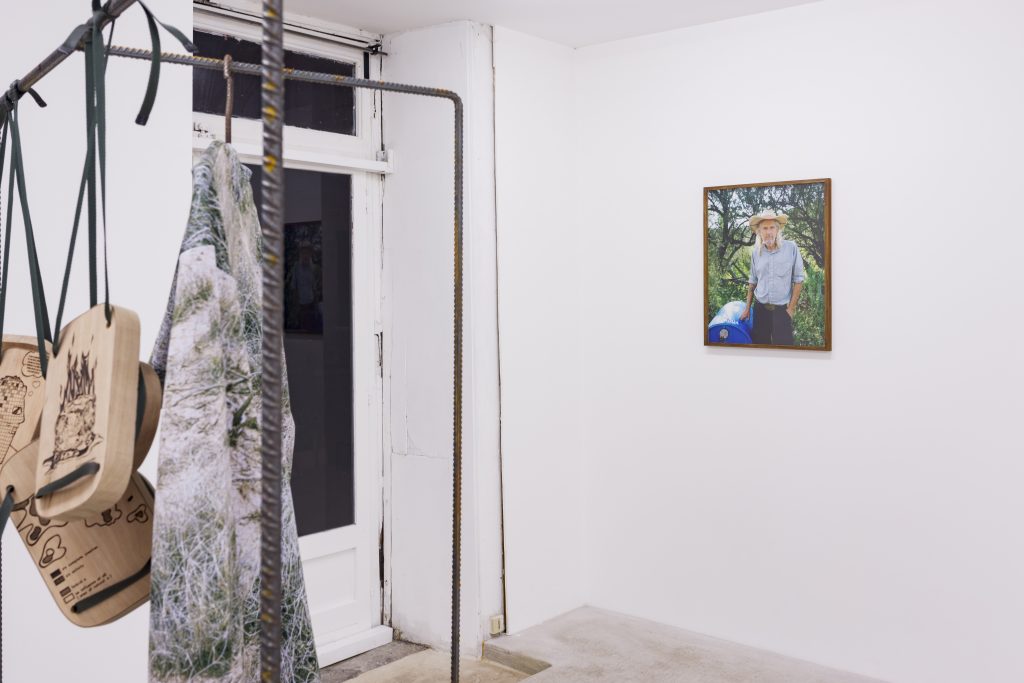
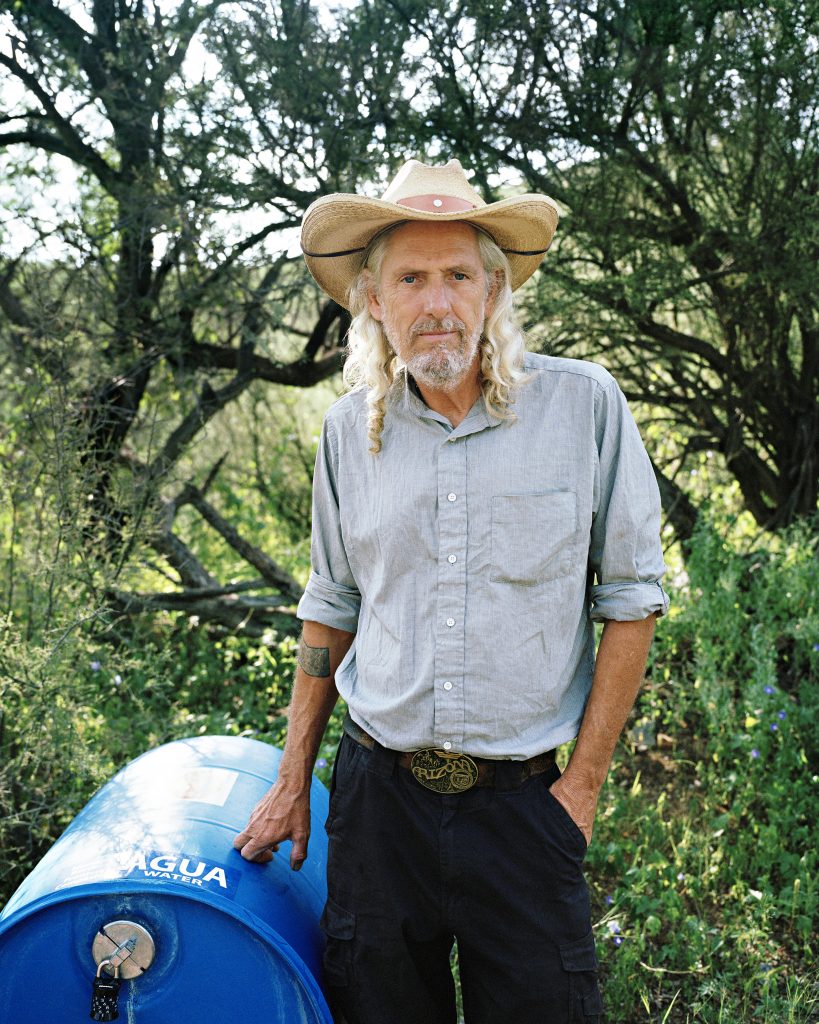
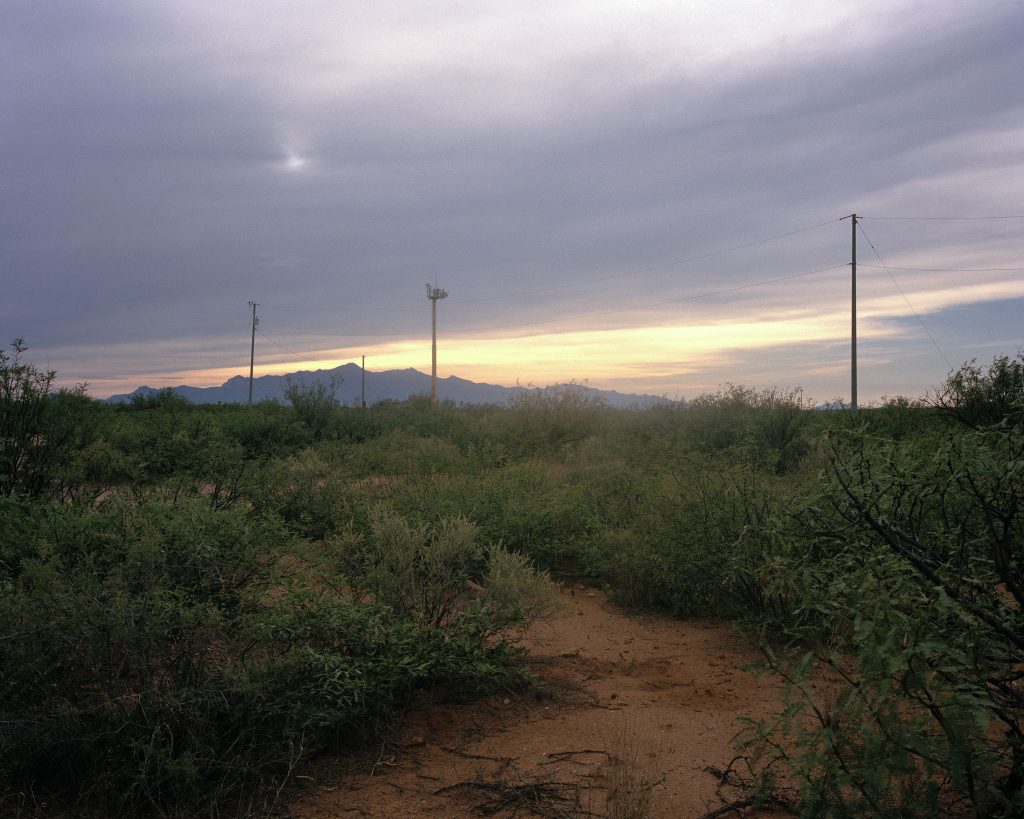
RVSS : a remote video surveillance system consists of multiple daylight and infrared cameras and a laser illuminator mounted on 30 to 90 feet tall monopoles, 12-foot-tall fixed towers and buildings. Command and control centers linked with communications equipment. Unlike the more common IFT (Intergrated Fixed Towers), RVSS does not include radar capability. The deployment and maintenance of surveillance technology as IFT and RVSS along the southwest U.S. is contracted with private companies, such as the construction of the wall, the transport and incarceration of arrested migrants.
In the Coronado Mountains, large caves may have been used by humans as a shelter and hideout by middle archaic people (up to 8000 years ago) and more recently by the Chiricahua Apache and other Apache peoples, Mexican and European miners, and settlers.
No archaeological evidence remains in the cave today. In mid 16thcentury Francisco Vasquez de Coronado marched from Mexico into St Pedro Valley, searching for the seven cities of Cibola and its fabled gold. Today, in the valley the border town of Naco is one of the poorest of the state.
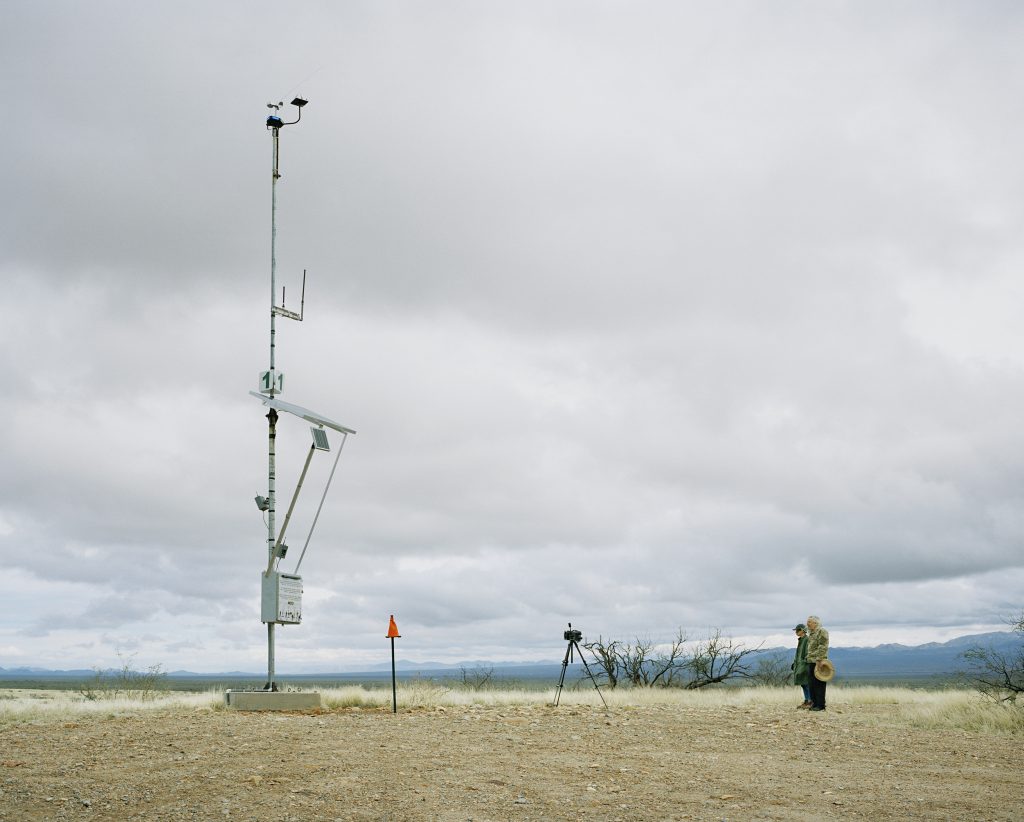
Rescue Beacons : Peppered across the vast, rugged desert along the southern border are dozens of 30-foot steel poles, each topped with a battery-powered strobe blue light. Rescue Beacons, also referred to as “desert beacons” and/or “panic poles,” are emergency transmission towers located throughout the southwestern U.S., along the U.S. /Mexico border. Primarily established in the Arizona Sonoran desert, where harsh environmental conditions lead to many migrant deaths, more have been placed eastward along the U.S./Mexico border since their original conception in 2001. They were implemented as part of the U.S. Customs and Border Protection Agency’s (CBP) ongoing Border Safety Initiative (BSI), initiated in 1998 to address the rising number of exposure-related deaths among migrants crossing illegally through Mexico into the United States. Border Patrol autorities says the strobes can be seen from as far as 10 miles, giving the Tucson Sector 340 miles of visibility at night. The beacons include pictorial instructions, as well as the same message in English, Spanish and Tohono O’odham: “If you need help push the red button. Rescue Personnel will arrive shortly to help you. Do not leave this area.” In the picture on the beacon, an unarmed character responds with a water gallon. In 2017, there were 34 rescue beacons in Border Patrol’s Tucson Sector. There were 10 active beacons in the Cabeza Prieta Wildlife Refuge, which covers 860,000 acres. That’s about one beacon every 135 square miles. To demonstrate that it’s addressing migrants dying in the desert, Border Patrol relies heavily on the rescue beacons as an humanitarian response. No More Deaths organisation, says the data behind rescue beacons, and a lack of transparency regarding that data, further proves they’re ineffective. The Department of Homeland Security report from fiscal 2015 breaks down the number of rescue-beacon activations and individuals rescued as a result by each sector of Border Patrol. In 2016 in the Yuma Sector, two rescues for 1,161 activations were recorded.
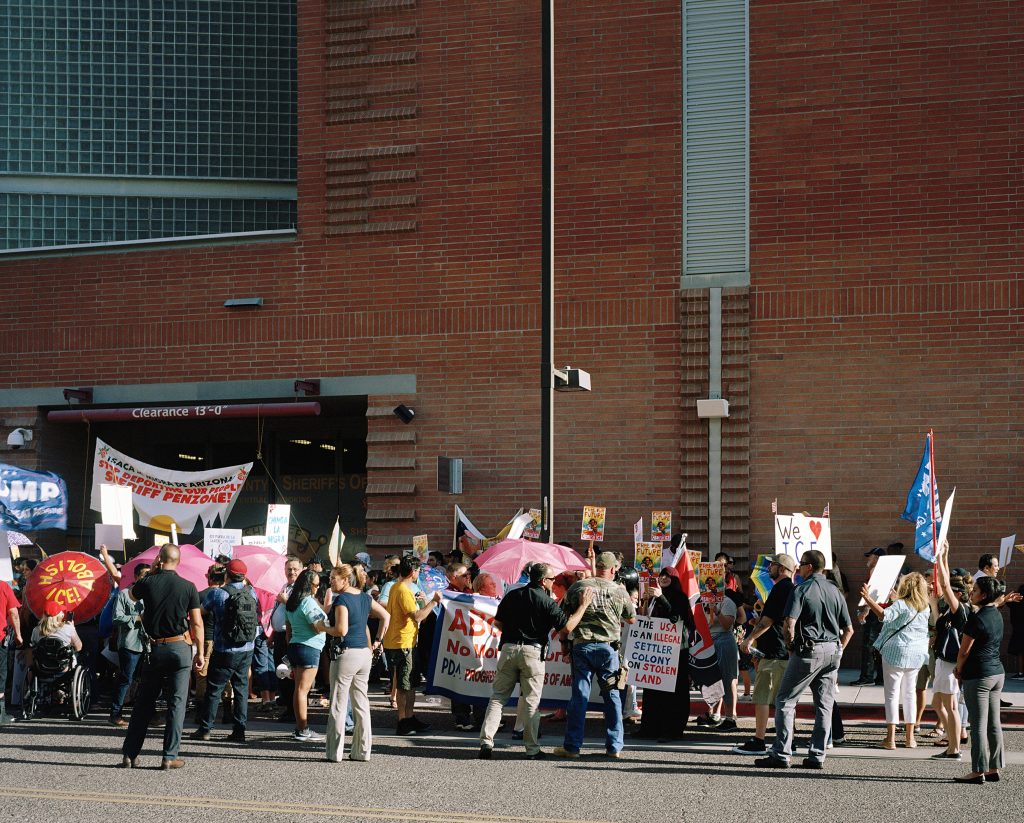
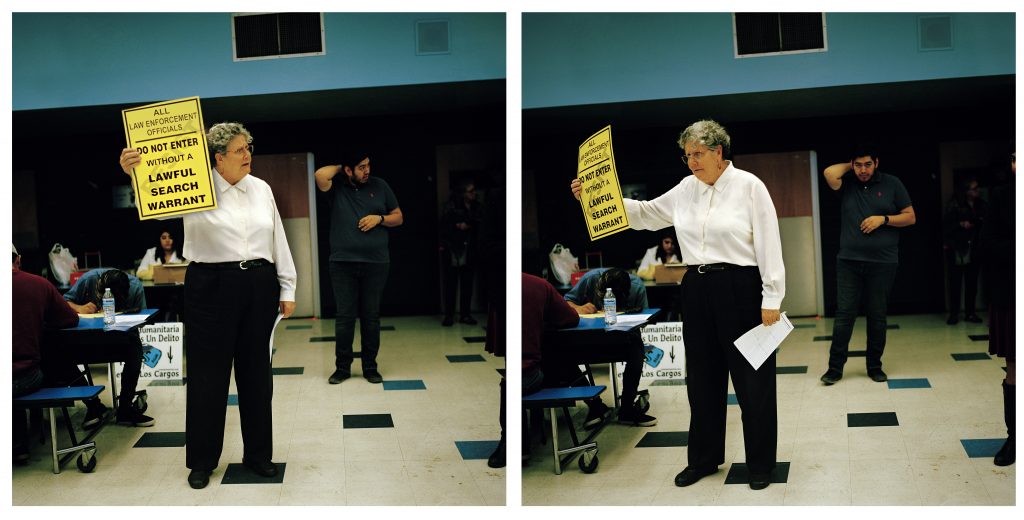
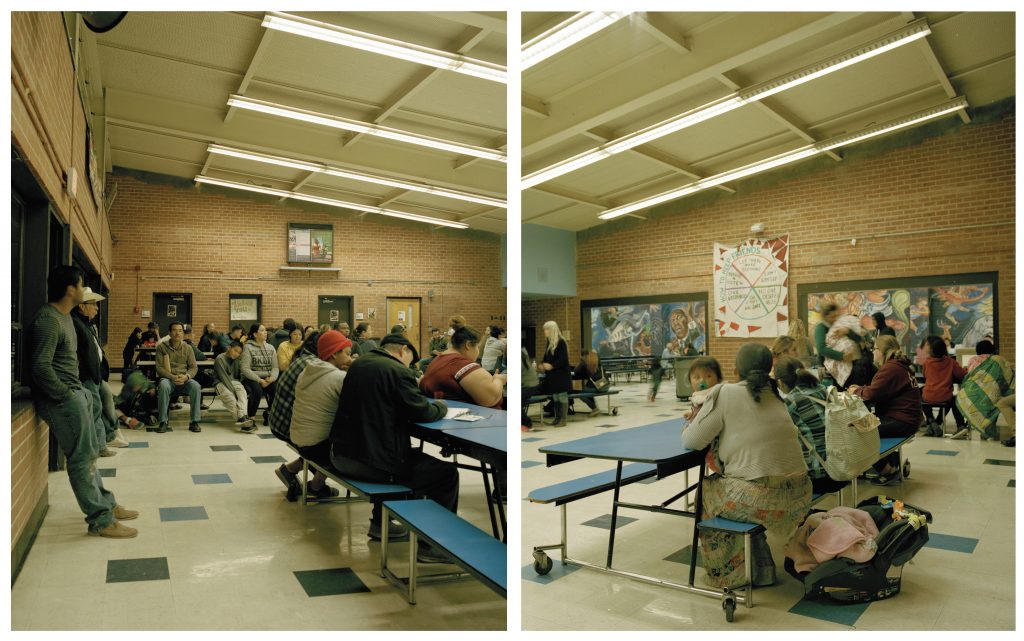
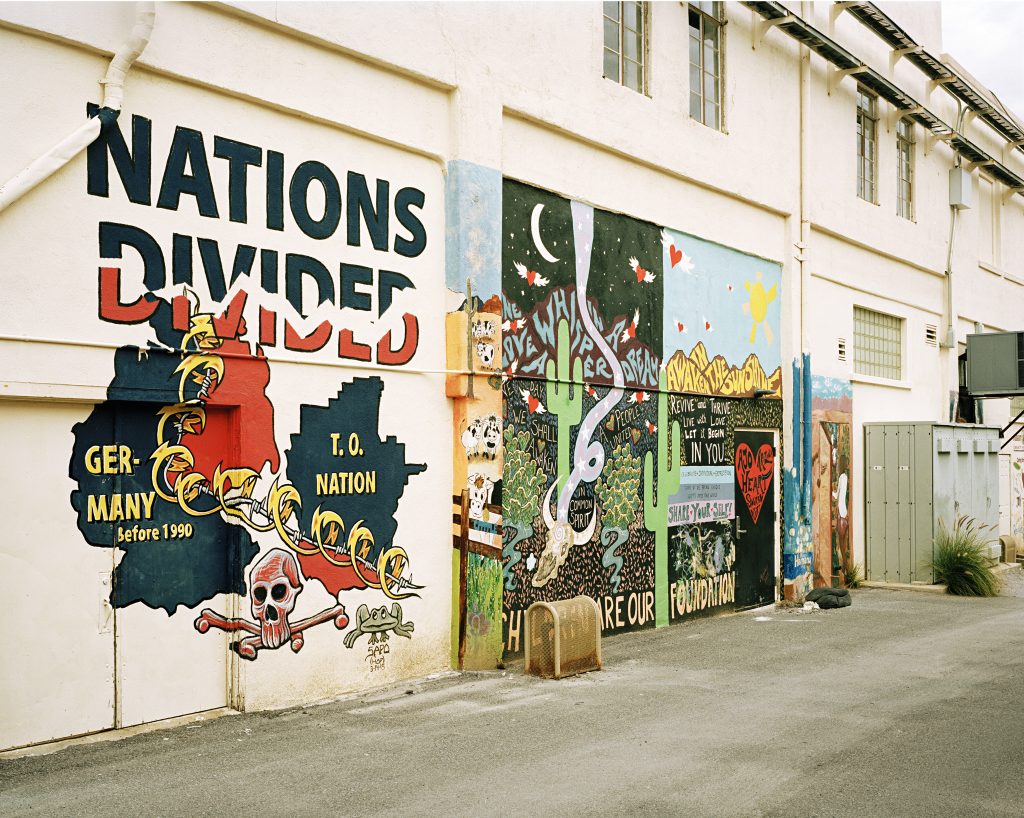
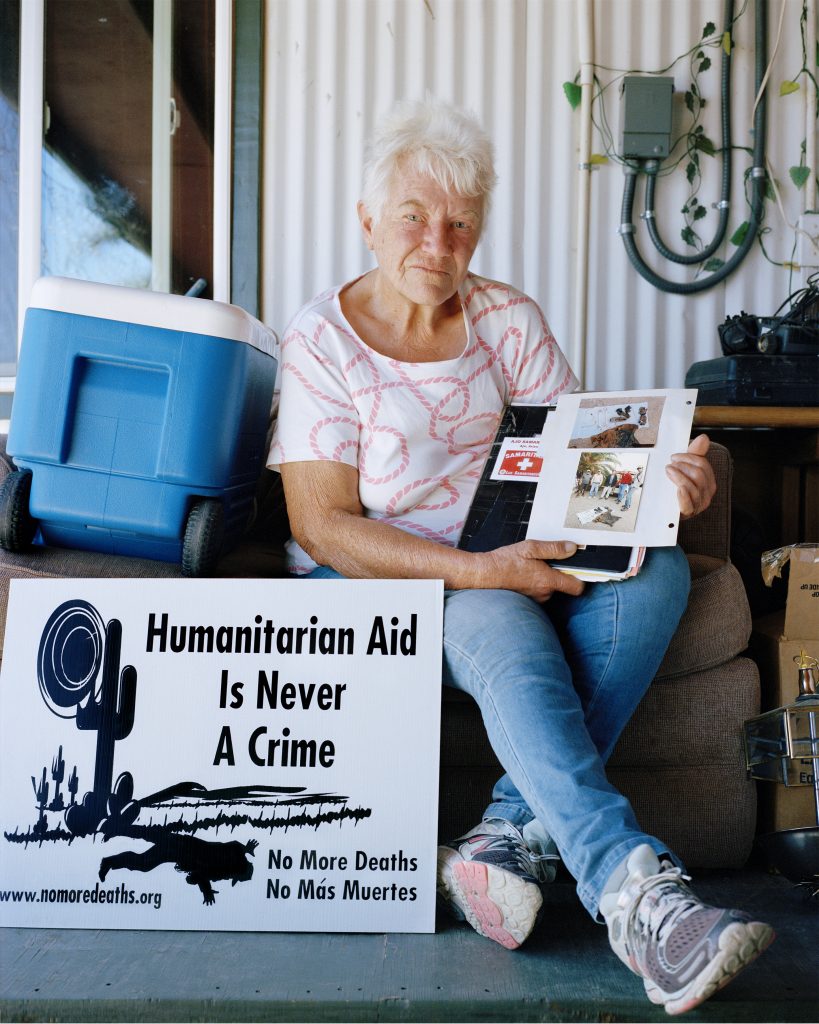
About No More Death Sign «Humanitarian aid is not a crime»(January 2019). Federal authorities had charged four No More Deaths volunteers – Caitlin Deighan, Zoe Anderson, Logan Hollarsmith and Rebecca Grossman-Richeimer – for leaving aid on the Cabeza Prieta refuge. Those charges were dropped in February 2019. A ninth volunteer, Scott Warren, is awaiting trial for both felony and misdemeanor charges of harboring and conspiracy related to humanitarian work for No More Deaths. The slew of legal cases caused the group to create a legal campaign in support of the “Cabeza 9.” Batches of white signs reading “Humanitarian aid is never a crime” are scattered in yards, curbsides and windows across Tucson
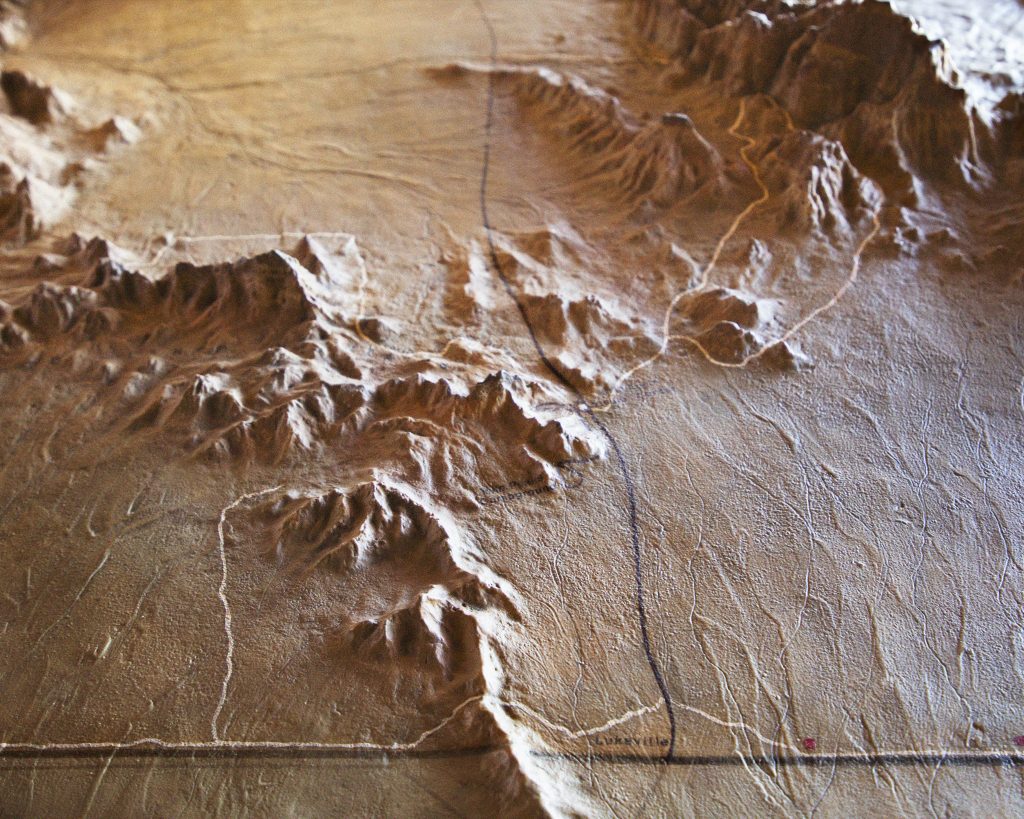
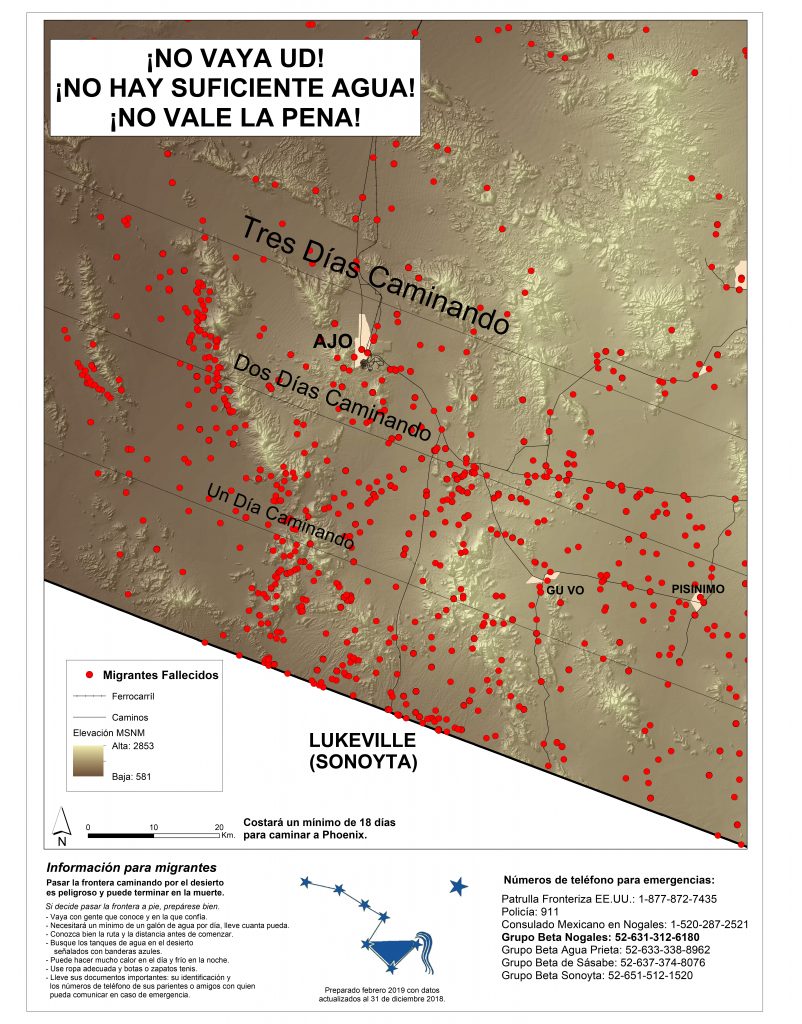
Representing body found in the sector since 2000. In partnership with the Pima County Medical Examiner’s Office, the association Humane Borders has developed created an updated migrant death map. Local posters, extracted of this map are distributed on the south side of the U.S. – Mexico border. formally known as the Arizona OpenGIS Initiative for Deceased Migrantthese posters warn potential undocumented migrants (“Don’t do it! It’s hard! There’s not enough water!”) of the dangers they face trying to cross through the desert on foot. The posters include estimated walking times from various entry points,
as well as the sites of migrant deaths and the location of water stations.
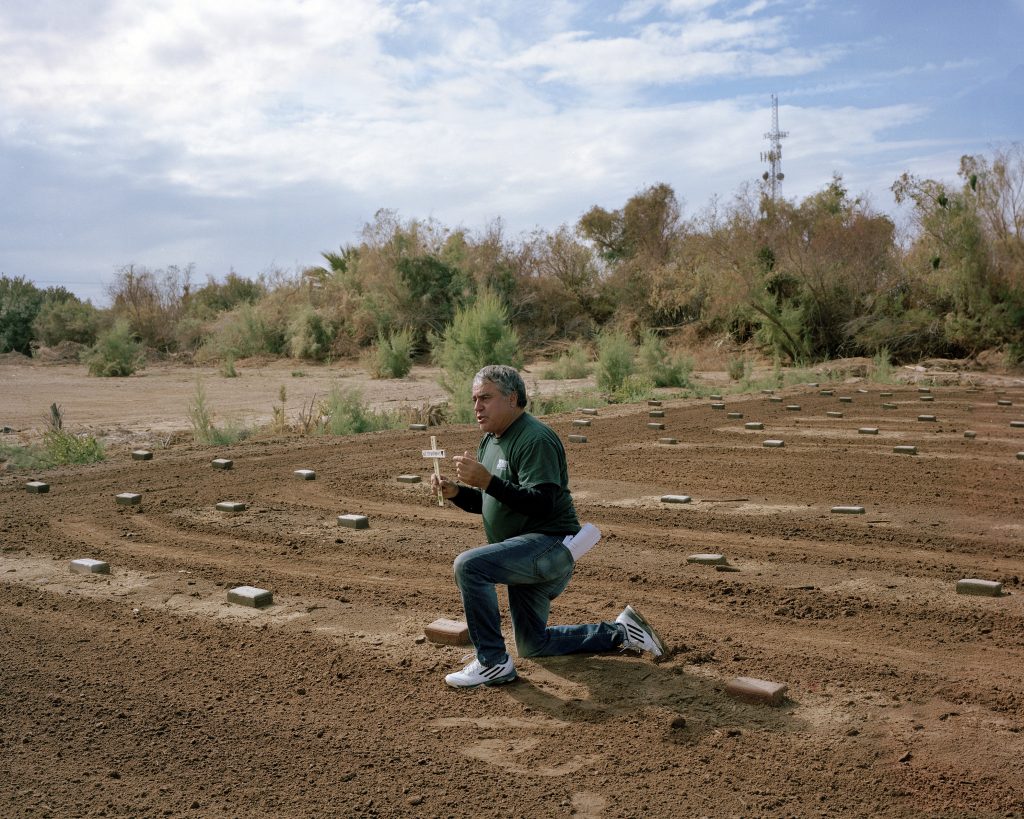
About Imperial Valley Cemetery : The biggest mass grave in the U.S is located in Imperial Valley, a desolated county of California where hundreds of unidentified migrants are buried. Long alignments of bricks engraved with data base numbers are located in the back of the cemetery, behind a tree line separating them from the rest of the graves. On each bricks is marked John Doe or Jane Doe to specify the gender of the unidentified bodies. There have been over 11,000 deaths since the border fence was erected by operation Gatekeeper in 1994, with one-third of these deaths unidentified. Border Angels visits the cemetery of “the not forgotten” every six weeks in order to pay homage and spread their message to the media and draw public attention.
About Border Angels : In January 1994, the start of the North American Free Trade Agreement (NAFTA) drove seven months later the subsequent implementation of Operation Gatekeeper, a measure which aimed at halting illegal immigration at the border near San Diego. The same year, the California Proposition 187 1(also known as Save Our State (SOS) initiative) was adopted to establish a state-run citizenship screening system and prohibit illegal immigrants from using non-emergency health care, public education, and other services in the state of California. Responding to the upsurge of local migration policy, Roberto Martinez and Enrique Morones, who had worked in local church humanitarian program since 1986, started Border Angels. Thirty years later, it’s the main active non-profit organization of Southern California that brings help to migrant brethren at the border. Border Angels organizes water drops in the desert and sponsor free immigration consultations in Tijuana and San Diego. for now, the only voice of the organisation is Enrique Morones, omnipresent in the media.
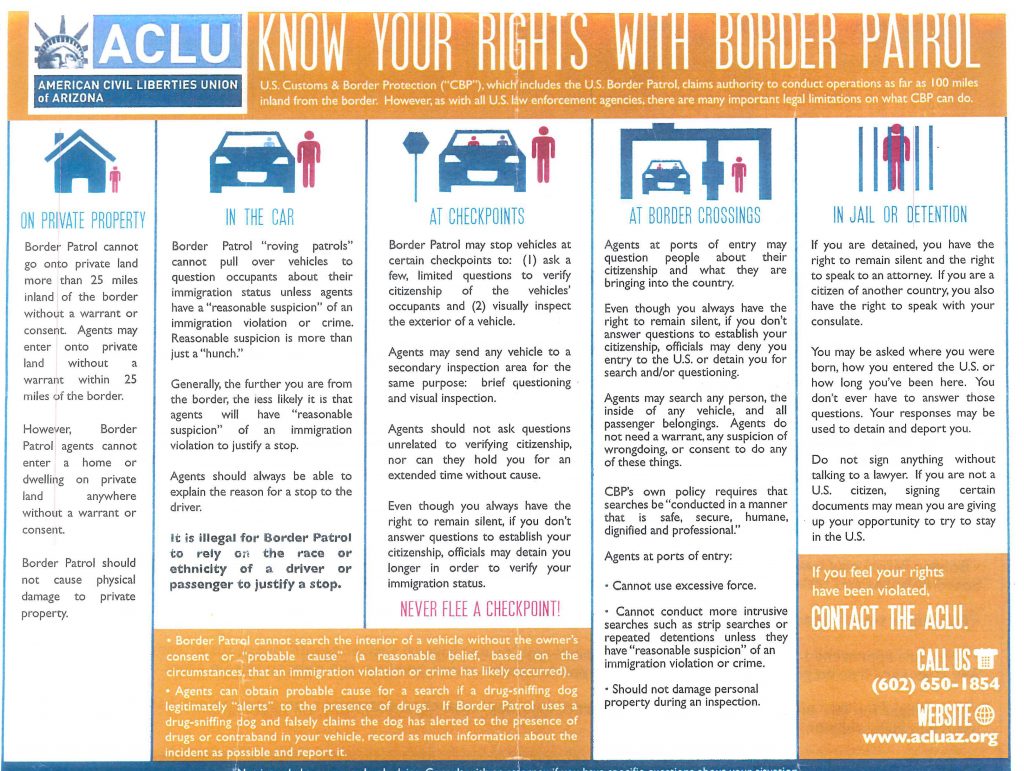
ACLU was born in 1920 during the so called Palmer Raids, a communist Hunt, when Attorney General Mitchell Palmer began arresting without warrant and deporting so-called radicals. In Arizona, ACLU fight against the «Show Me Your Papers» law SB 1070 wich was passed by the Legislature and Joe Arpaio ex-sheriff of Maricopa County. The Support Our Law Enforcement and Safe Neighborhoods Act (SB 1070) is a 2010 legislative Act in the U.S. state of Arizona that at the time of passage in 2010 was the broadest and strictest anti-illegal immigration measure passed in the United States. U.S. Federal law requires aliens older than 18 to possess proper identification at all times; violation of this requirement is a federal misdemeanor crime. The Arizona act additionally made it a state misdemeanor crime for an alien to be in Arizona without carrying the required documents, required that state law enforcement officers attempt to determine an individual’s immigration status during a «lawful stop, detention or arrest», when there is reasonable suspicion that the individual is an illegal immigrant. The law also imposed penalties on those sheltering, hiring and transporting unregistered persons. The paragraph on intent in the legislation says it embodies an «attrition through enforcement» doctrine. Shortly after SB 1070 was signed in 2010, the ACLU and the U.S. Department of Justice filed lawsuits challenging the law, charging that it is unconstitutional and encourages racial profiling. Between 2010 and 2016, courts have rendered unenforceable many parts of the law:
Section 3: A.R.S. § 13-1509: This provision made a person’s failure to comply with federal noncitizen-registration requirements a state misdemeanor. It was struck down because federal law preempts it.
Section 5: A.R.S. § 13-2928(A) and (B) day labor prohibitions: These provisions made it unlawful for occupants of vehicles stopped on roadways and impeding traffic from trying to hire people for work at another location and for individuals to enter such vehicles in order to be hired. It was struck down on First Amendment grounds as an unconstitutional limit on freedom of speech.
Section 5: A.R.S. § 13-2928(C): This provision made it a misdemeanor for unauthorized noncitizens to seek or engage in work in Arizona. This provision was struck down because it is preempted by federal law.
Section 6: A.R.S. § 13-3883(A)(5): This provision authorized officers to arrest a person without a warrant if the officer had probable cause to believe the person committed any public offense that would make the person removable from U.S
In 2019, The U.S. Supreme Court still did not strike down the most hotly disputed part of Arizona’s anti-immigrant law, Section 2(B). This “show me your papers” provision requires police to make a reasonable attempt, when practicable, to determine the immigration status of anyone who is lawfully stopped when the officer has “reasonable suspicion” the person stopped is not in the U.S. with proper documentation.